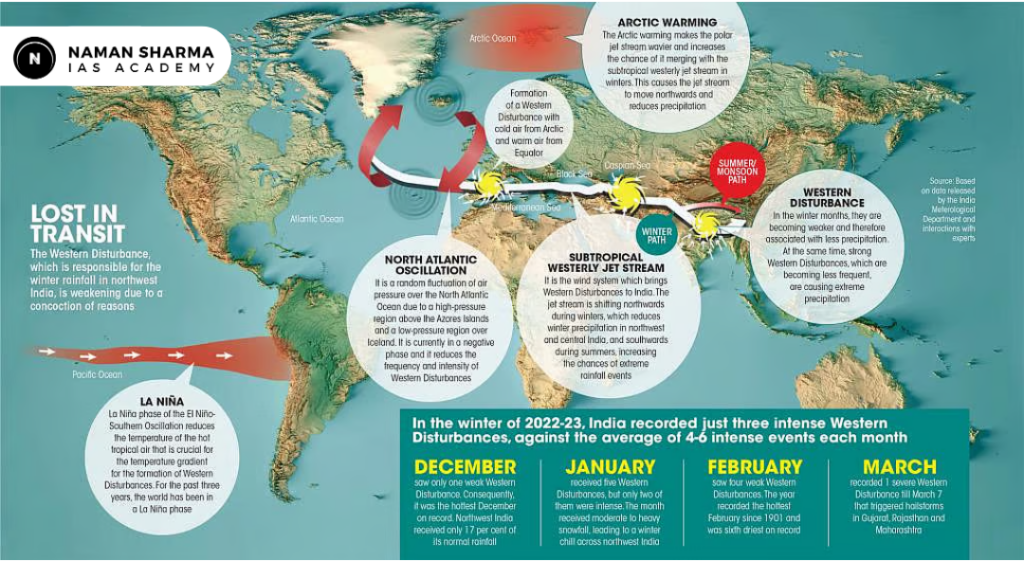Western Disturbances
Heavy rainfall and strong winds disrupted life. in Delhi due to a fresh splash of Western Disturbances over North India
What are Western Disturbances?
- Western Disturbances are a series of Western Disturbances are a series of cyclonic storms that originate in the Mediterranean region and Black Seas, travel over 9,000 km to bring winter rains to northwest India.
- A Western Disturbance collects moisture from the Mediterranean Sea, Black Sea, and Caspian Sea and traverses over Iran and Afghanistan before hitting the western Himalayas.
- While the storm systems occur throughout the year, they travel to India mostly between December and April because the trajectory of the subtropical westerly jet stream, which transports them, shifts during the winter months to the rim of the Himalayas
- For the rest of the year, the jet stream travels from above the Himalayas to the Tibetan Plateau and China.
- Its trajectory changes as per the position of the Sun.
Permanent Winds
The winds that blow constantly throughout the year are called Permanent Winds. They also blow constantly in a particular direction.
There are types of permanent winds:
- Trade Winds – These are permanent winds flowing from east to west. It flows in the Earth’s equatorial region (between 30°N and 30°S latitudes).
- Easterlies – It is a prevailing wind blowing from the east. The trade winds in tropical regions and the prevailing winds in the polar regions are easterlies.
- Westerlies – These are prevailing winds that flow from the west towards the east. It flows in the Earth’s middle latitudes between 30 and 60 degrees latitude.
- Also called anti-trades, these winds originate from the high-pressure areas in the horse latitudes and trend towards the poles and steering extratropical cyclones in this general manner.
How are Western Disturbances Affected by Other Climatic Phenomena?
La Nina Event
- For the past three years, the world has been in a La Niña phase, which refers to the cooling of the ocean surface temperature in the Pacific Ocean.
- It weakens the temperature gradient for the formation of Western Disturbances as it reduces the temperature of the hot tropical air.
North Atlantic Oscillation:
- Western Disturbances are also influenced by the North Atlantic Oscillation, a random fluctuation of air pressure over the North Atlantic Ocean due to a high-pressure region above the Azores Islands in the central North Atlantic and a low-pressure region over Iceland.
- Due to this, the weather system is currently in a negative phase, as both low- and high-pressure systems are weak, and it makes Western Disturbances 20% less frequent and 7% less intense than a positive phase.
Impact of Western Disturbances on India
- Winter Rainfall & Snow:
- Primary source of winter precipitation in North India, crucial for Rabi crops in Punjab, Haryana, and western UP.
- Moderate Heatwaves:
- Frequent WDS reduce summer heat intensity across northwest and central India.
- Triggers Extreme Weather:
- Causes hailstorms, flash floods, and landslides, especially in Himalayan states like J&K and Himachal. Overlapping WDs during pre-monsoon and monsoon months disrupt rainfall patterns and intensify precipitation. In 2025, WDS caused hailstorms in Bihar, Himachal, Vidarbha, and flooding in Telangana and Delhi, as per IMD warnings.
Climate Change Impact on Western Disturbances:
- Increased Frequency: More WDs observed post-January 2025, especially in March–April.WDs now occur in May–July, beyond their usual Dec–Mar peak. (e.g. Weather and Climate Dynamics journal (2024)
Stronger Jet Streams: Climate change has intensified subtropical westerly jet streams, allowing.

Western Disturbances
WDs to travel wider and deeper. (e.g. this causes more meridional oscillations, leading to erratic rain and snowfall. Moisture Surge from Arabian Sea: Rapid warming (1.2°C–1.4°C rise in SST) increases moisture availability.
E.g. Heavier rainfall and flash floods across North and Central India.
Interaction with Southwest Monsoon:
- The warming of the Arctic region makes the polar front jet wavier, causing Western Disturbances to visit India more frequently during summers.
- Western Disturbances during summer, monsoon, and post-monsoon periods increase the chances of them interacting with the southwest monsoon and other associated local convection systems, such as tropical depressions that travel northward from either the Bay of Bengal or the Arabian Sea.
Mains Practice Question
Questions: Discuss the concept of air mass and explain its role in macro-climatic changes.(UPSC 2016)
Prelims Practice Question
Question: [UPSC 2015] Consider the following statements:
1. The winds which blow between 30° N and 60° S latitudes throughout the year are known as westerlies.
2. The moist air masses that cause winter rains in the North-Western region of India are part of the westerlies.
Which of the statements given above is/are correct?
(a) 1 only
(b) 2 only
(c) Both 1 and 2
(d) Neither 1 nor 2
Explanation:
Statement 2 is correct:
- The moist air masses that cause winter rains in the North-Western region of India are indeed part of the westerlies.
- These winds flow from the west towards the east between 30° and 60° latitudes, bringing moisture from the Mediterranean Sea and other sources.
Statement 1 is incorrect
- The winds that blow between 30° N and 60° S latitudes are known as the trade winds, not the westerlies.
- The westerlies blow between 30° and 60° latitude in both hemispheres. The trade winds blow from east to west.







